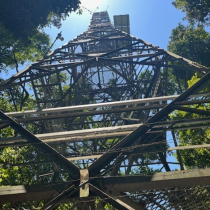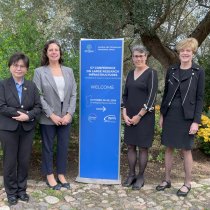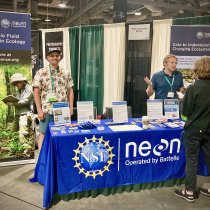Synergies between NEON and the LTER Community
October 18, 2018
In early October, hundreds of scientists from the National Science Foundation’s LTER Network gathered together in Asilomar, CA for their All Scientists Meeting, which takes place once every three years. It’s a great opportunity for LTER-related scientists to share their discoveries, progress and best practices.
This year, LTER invited Sharon Collinge, Observatory Director and Chief Scientist for the NEON program, and NEON Data Science lead, Christine Laney to discuss how NEON’s data and infrastructure may be used to support LTER initiatives. Staff scientist, Eric Sokol also works closely with members of the LTER community and co-organized several sessions.
Christine presented a 90-minute workshop titled: NEON Data: From Collection to Publication, which provided a general overview of the field, instrumented, and remote sensing data the NEON project collects; how the data are processed, quality checked, and documented; and how the data are published and made accessible to the community. About half of the session was a Q&A about NEON data collection and processing.
She also presented on behalf of two other NEON project scientists during another workshop entitled: “Better Monitoring through Uncertainty Analysis: Optimize allocation of effort, save time and money.” In that workshop, Christine spoke about Caren Scott and Kaelin Cawley’s work to optimize NEON’s aquatic sampling design.
Other opportunities for cross collaboration discussions included two LTER-CZO-NEON sessions in which participants discussed the pursuit of synergies between the US Long-term Ecological Research (LTER), Critical Zone Observatory (CZO) and National Ecological Observatory Network (NEON) programs, which rely on different, but complementary approaches to network-enabled science.
Why Attend the LTER Meeting?
According to Christine, “LTER is one of our primary audiences in the research community. While many LTER members also attend the annual Ecological Society of America (ESA) meeting, it is only once every three years that they have their own conference. The ASM is a great opportunity for us to learn about cutting-edge ecological research across the United States (some sites are co-located with NEON sites), and share detailed information about NEON resources and status with this community.” In that spirit, Eric used the meeting to co-organize several sessions that cross cut NEON and LTER initiatives such as next steps for researchers focused on synthesizing of LTER biodiversity data and discussions on what "connectivity" means for the different disciplines represented in the LTER network and NEON user community. One particularly interesting session was about an Environmental Data Initiative (EDI) project to create a standardized data pattern and an R package for data discovery called "ecocomDP". Eric has been collaborating with EDI to include NEON biodiversity data in the data discovery functionality of ecocomDP.
Finally, Sharon presented a keynote address at the meeting in which she introduced NEON as “the community’s observatory” and encouraged attendees to engage with NEON. Sharon noted that “LTER represents a full spectrum of ecologists that can leverage NEON data and infrastructure to enhance their research programs, and that can provide deeper understanding and interpretation of NEON’s continental-scale observations.”



